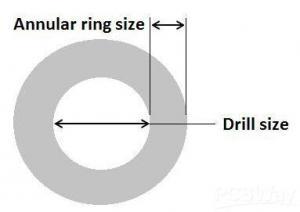
What is an Annular Ring?
As we all know, annular rings are considered one of the biggest concerns for PCB manufacturers today. It is because these rings stand as a source for drilling the PCB board easily. Most commonly, it is seen that when PCB boards are drilled, then the remaining copper surrounding the hole gets termed as an annular ring.
The significance of this particular ring is that it acts as the wall of the drilled via. The overall size of the annular ring also depends on the size of both via and copper pad. But why are annular rings so important in PCB manufacturing.
Many of us might not know that PCBs are usually multifaceted and can be connected by another pad through the internet. Annular rings act as the connection between both the circuit board and the other layers. Another interesting fact about the annular rings lies in their thickness. It is said that the thicker the annular ring, the more strong connection it can have.
Depending on all these factors, the PCB annular ring is designed. But how thick the ring should be, and what are the other factors to keep in mind? All these are answered in this blog below.
What Is An Annular Ring?
The annular ring is nothing but a technical term that is designated to the area drilled into the PCB. The hole that is created by the process serves as an interconnecting node between different layers of the circuit.

But before you know the basics of annular ring creation, it is important to know how the via is made. It usually starts during the PCB manufacturing process. To fulfill the general requirements, PCB boards are etched with a hole in which copper is deposited through electroplating.
After the PCB construction is finished, these hole-like structures that act as a connection between PCB pads appear as rings when viewed from above. Another specialty of annular rings is that they differ in size. Depending on the requirement, they can either be thick or thin.
How Do You Calculate The Annular Ring?
We all know that in a multilayer PCB, the routes are connected from one layer to another with the help of the via. But when it comes to the mathematical calculation of the annular ring, it is done by a simple formula.
For the annular ring calculator to work, usually, the difference between the diameter of the pad and the hole is taken out. The result is then divided into two. Thus, the formula for the annular ring calculation goes by:
Annular ring = (Diameter of the copper pad-Diameter of the via)/2
Apart from this, the calculation of the overall width of the annular ring also plays a key role in PCB manufacturing. It is because if there is insufficient width, then the hole that could touch the pad is termed as Tangency. Also, in some cases, the hole is situated outside the boundary of the pad. Thus, to avoid both these situations, annular ring calculation is very important.
Why Does the Annular Ring Size matter?
As we all know, that annular rings are meant to connect the PCB with a reliable electrical connection. Thus, in a foremost way, the ring size must allow cords to pass through it easily. Also, another thing to pay attention to is that the minimum size of the annular ring shall be greater than or equal to the overall specified design.
If any of the above conditions do not meet, it results in discrepancies called “Tangency”, “breakout”, and undesired annular ring. One of the prime factors to remember when constructing a PCB board is that all the annular rings shall be carefully crafted. Only this will result in the proper working of the circuit.
Common Annular Ring Issues:
Like every electrical component, the construction of annular rings is not devoid of any issue. This means that apart from the major problems such as Tangency, Breakout, and Undesired Annular ring, there are other common issues.
This includes the misregistration of the via. As discussed earlier, annular rings must be drilled in the absolute center of the pad for proper functioning. But in some cases, the minimum width of the ring is unequal, which leads to marginal interconnections, reliability problems, and increased resistance.
All these problems can be sorted out with the correct placement of the annular ring PCB.
What Is Tear Drop Annular Ring?
Tear Drop PCB is named as such due to the unique shape it possesses. These types of annular rings are a common feature in the teardrop pads. One of the prime aspects of these pads is that this type of shape increases the overall structural integrity against all types of stress.
Apart from all these benefits, the teardrop shape also increases the tolerance in the pad. Also, the teardrop annular rings are a match for conductors, which have a width of fewer than 20 mils.
How Can Absolute PCB Team Help You?
The absolute PCB is one of the best companies present today, which delivers all kinds of support in PCB services. What makes them different from the rest is that they help address every PCB problems the customers have.
From manufacturing to assembling a PCB board, the company is best for getting access to high-quality PCB boards. Thus, if you are looking for an address for all your PCB needs, then Absolute PCB is the one-stop destination.
Conclusion:
If you have followed the above article carefully, then you will be able to note down all the fundamentals of annular rings. The guide is essentially a route to track down common questions related to PCB and annular rings in general.
In addition to this, we have also covered the common discrepancies found in annular ring construction and how to calculate them. Annular rings have become a source of discussion for many PCB companies across the world. Thus, for all those who need to know the basics about these doughnut-shaped structures, the article is best in every way.

